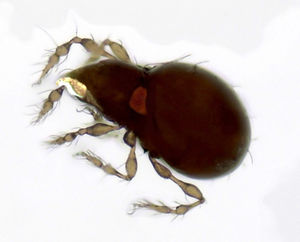Oribatida
Oribatida, or oribatid mites, are an order of mite, and the oldest mite group, found present in fossils over 400 million years ago.

Abundance and Diversity
Oribatid mites are distributed worldwide and are commonly found at a density of 50,000 to 500,000 individuals per square meter in soils. Oribatid mites are known to predominate over other groups of mites and mesofauna in most soils. They live in all terrestrial ecosystems, including the arctic and the tropics. Coniferous forests typically have the highest numbers of oribatid mites, followed by deciduous hardwood forests, grasslands, deserts, then tundra. Their numbers are reduced in highly developed or agriculturally developed areas. Oribatid mites are a highly diverse order of mites, with varying numbers of species being found in different areas based on habitat, however, there are well over 150 different species reported in some areas. In addition to being one of the most abundant soil species, oribatid mites are an arboreal species as well, which was not discovered until recently (~20 years ago).
Biology
Oribatid mites are 0.2 to 1.5mm in size, brown or colorless, with high amounts of calcium in their shells, which is sequestered through fungal feeding. They reproduce slowly compared to other types of mites, with a life cycle of about a year. Oribatid mites differ from other microarthropods by having a sclerotized exoskeleton, resembling the millipede. They are subject to juvenile polymorphism, in which immature oribatid mites are so morphologically different than adult mites that it is difficult to draw any relation between them.
Scientific Classification
Kingdom: Animalia
Phylum: Arthropoda
Subphylum: Chelicerata
Class: Arachnida
Subclass: Acari
Superorder: Acariformes
Order: Oribatida
Feeding Habits
Oribatid mites are categorized into three types of feeders. Microphytophages feed on fungi, macrophytophages feed on vegetable matter, and panphytophages feed on both. Most oribatids are obligate fungal feeders.
Oribatid mites themselves are prey for many insects such as scydmaenid beetles, pselaphid beetles, or ants.
Impacts on Soil
Oribatid mites affect litter decomposition and the nutrients in soils by grazing on microbial populations and fragmenting plant detrius. This affects the decomposition process indirectly, but significantly. They play an important role in soil food webs via regulating the decomposition of organic matter and propagating microorganisms within the soil.
References
[1] Heethoff, M., M. Laumann, and P. Bergmann. 2007. Adding to the Reproductive Biology of the Parthenogenetic Oribatid Mite, Archegozetes longisetosus (Acari, Oribatida, Trhypochthoniidae). Turkish Journal of Zoology 31:151–159.
[2] Encyclopedia of Entomology. 2005. . Reference Reviews 19:48–49.
[3] Manu, M., V. Honciuc, A. Neagoe, R. I. Băncilă, V. Iordache, and M. Onete. 2019. Soil mite communities (Acari: Mesostigmata, Oribatida) as bioindicators for environmental conditions from polluted soils. Scientific Reports 9:20250.
[4] Coleman, D. C., D. A. Crossley, and P. F. Hendrix. 2004. Fundamentals of soil ecology. 2nd ed. Elsevier Academic Press, Amsterdam ; Boston.
[5] Wissuwa, J., J.-A. Salamon, and T. Frank. 2013. Oribatida (Acari) in grassy arable fallows are more affected by soil properties than habitat age and plant species. European Journal of Soil Biology 59:8–14.